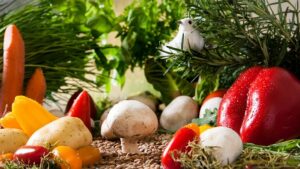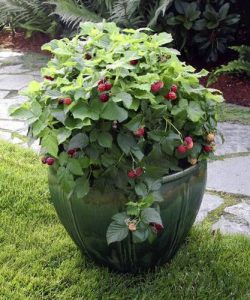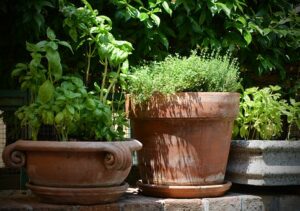How to Foodscaping Guide

The awareness of self-sustainability has increased and is on the rise since the pandemic, homeowners are no longer growing ornamental plants but ripping out flower beds to grow edible gardens and there are others that are intergrading both edible and ornamental plants to create not only beautiful landscapes but a garden that provides foods in a control and confined environment.
This method of growing foods is known as foodscaping (the integration of ornamental and edible plants) which has become so popular. This type of gardening is also known as edible landscaping which is a crossbreed between farming and landscaping. If your desire is to create a foodscape garden then look no further you have come to the right place as we equip you with the knowledge to become a successful foodscaper.
Affiliate Disclaimer
As an Amazon Associate and the Owner of this Website, I’ve tracked down special deals for some of the products mentioned here. When you use the links on this page to make a purchase I may get a small commission and you will get a great bargain. It’s a WIN-WIN for both of us
Install Flower Vegetables
Growing vegetables that flower is a great way to foodscape, this practice will not only provide you with an edible garden but a garden that flowers, some vegetables that flowers include Cauliflower, Bok Choy, Jerusalem Artichoke, Scallions, Broccoli, Courgette Blossom, Squash Blossom, Marrow Blossom, Swiss Chard, Cabbage, Spinach, Legumes, Leeks, Kale, etc.. we have not forgotten, there are also flowering herbs that can be integrated into your foodscape garden.
Install Flowering Herbs
Herbs do have their place in the garden, what I love about herbs besides the health benefits are the taste and the aroma. Herbs can really flavor foods, both my wife and I have a herb garden at the front of our property right at our fingertip. We harvest and use these herbs to flavor the many dishes we prepare, here are some examples of herbs that flower. Garlic, Rosemary, Spearmint, Bee Balm, Dill, Lavender, Greek, Oregano, Chives, Mustard, Thyme, Chamomile, Sage, Arugula, Savory, Marjoram, Borage, etc…
The Use of Containers
Starting a container garden is a great way to foodscape especially if you don’t have the space, it’s all a matter of knowing what to grow from these containers based on the size of the containers and the plants at maturity. These containers can work well with your foodscape garden, you can install flowering herbs or veggies in containers, keep in mind however that the soil of container-grown plants dries out faster than plants that are installed directly into the ground so keep a check on the soil every couple of days and water as needed.

Grow bags can work as well, what I love about grow bags is they are easy to carry and can be reused, with grow bags you can grow vegetables, small fruit trees, and herbs.
Another container that I found to be so helpful to make growing edible plants easy and where you can grow multiple plants or a group of plants in one place is this container that is so efficient saving time while bringing great results.
Installing Climbers in your landscapes
Edible foods such as tomatoes or melons can be planted near fences, especially chain-link fences, these climbers will serve as a beautiful edible barrier or screen providing you with privacy. Just think outside of the box and go for it and remember to have fun because you’re in control, you’re in the driver’s seat. Strawberries can also be installed and used as a ground cover or better yet an edible ground cover.
Integrating Fruit Trees and Herbs
Another great way to intergrade plants is to plant herbs in containers and place the containers at the base or around the trunk of fruit trees or plant herbs directly into the soil around the base of fruit trees. Don’t be afraid to experiment and get creative.
Installing Plants that Deter Wildlife
The presence of wildlife such as rabbits, voles, deer, etc… is a cause for concern the good news however is there are many edible plants that will keep wildlife at bay. Some of these plants include shallot, chives, garlic, leeks, and onions will keep voles and moles at bay.
Garlic will deter deer, voles, and moles, onion has the seem effect. Lavender will repel mosquitos and other insects, plant bee balm near your herb garden to deter deer, rosemary will deter mice, rats, and deer. The list is endless with how you can deter wildlife with edible plants
Best Pest Management Practices in your Foodscape Garden

Because of the integration of a variety of plant species, there is much biodiversity activity, because you’re combining different species of plants caution must be taken if you discover that you have a pest issue. There are many pesticides that will bring garden pest insect control but because of the formulation or how they were produced can be very harmful to humans, pets, wildlife, and beneficial insects.
When treating edible plants for garden pests ensure products that are used are organic, human, and pet-friendly, products should only be used that are labeled for vegetables, fruits, and herbs. Before using any pesticides read and follow the manufactures label for the best results. This is a great organic product that can be used in helping to control garden insect pests.
Note: Before applying the practice of foodscaping ensure that you are abiding by the rules and the regulations of the Homeowners Association especially when it comes to installing an edible garden in front of your property.
The Benefits of Foodscaping
- Growing your own foods in a healthy way for example an organic garden
- Increasing food availability for you and your family
- Saving money on your grocery bill
- Edible gardens require less water than an ornamental garden
The final word on what is foodscaping
Foodscaping is a great practice that gives the best of both worlds by combining ornamental and edible plants in a controlled environment that’s of great benefit to humans, pollinators, beneficial insects, and wildlife as well. This gardening method assists in helping to bring balance to our ecosystem (biodiversity) which is a win-win. If your desire is to intergrade edible plants with your ornamental plants this guide is here to help you. This style of gardening can also be considered companion planting where the integration of plants works together to enhance each other’s growth or to protect each other from pests.
About the author
Norman loves being in the garden, both at home and for his job....
he is 'Natures Little helper' being outdoors, growing his vegetables and flowers from an early age.
Now having spent over 22 years in the profession he want to give some of his knowledge to others...
his vast array of hints and tips you will find scattered over this site will help you no end growing plants in your garden.
